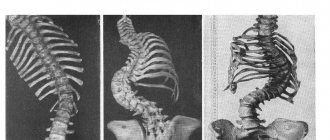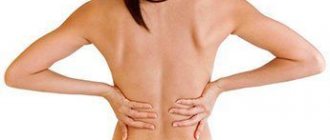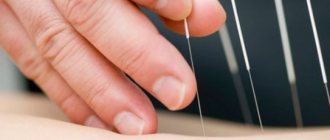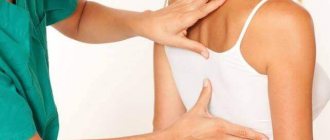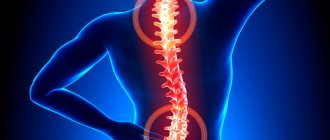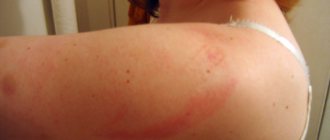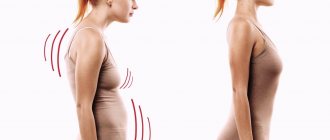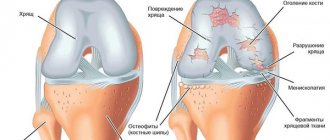Scoliosis 1st degree is a deformity of the spinal column in which the curvature in the lateral plane predominates.
Children of preschool and school age are considered to be at particular risk.
- Is one shoulder higher than the other?
- Has your gait or leg length changed?
- Do you have chronic neck or lower back pain?
In this article we will look at what the term “1st degree scoliosis” means, how to deal with it correctly and avoid relapse.
You will learn how to diagnose and treat this problem.
Fig: scoliosis 1 or scoliosis 2
How to determine the presence of pathology yourself?
There is a simple test: ask the person to stand straight, with his back to you and gently bend over. It is advisable to touch the floor with your hands, your knees should be straight.
If you have scoliosis, you will notice that one half of your back is higher than the other.
Fig: how to identify scoliosis
A patient who has grade 1 scoliosis experiences aching pain in the back.
They develop after exercise or long walks.
A doctor (neurologist or orthopedist) can reliably diagnose the disease based on an x-ray.
Rehabilitation period
If scoliosis causes neck pain, a person has no choice but to consult a doctor. After treatment, the patient will undergo rehabilitation, during which it is necessary to follow the strict instructions of the attending neurologist
:
- You should not engage in activities that place unilateral stress on the neck.
- We need to reconsider the organization of places to sleep and work.
- Wearing an orthopedic corset is often indicated, which will support the spine in the correct position.
What are the degrees of scoliosis?
Depending on the angle of deviation from the frontal axis of the spine, it has 4 degrees
- 1st degree is characterized by a deviation of up to 10 degrees;
- 2nd degree is a deviation from 11 to 25 degrees;
- 3rd degree has a deflection angle from 26 to 50 degrees;
- Grade 4 is characterized by a deviation angle above 50 degrees.
Fig: Degrees of scoliosis
Remember!
Pathology tends to progress over time.
This happens especially quickly in the absence of proper treatment.
Forecast
In advanced stages of neck scoliosis, it is necessary to wear special bandages. Mild and moderate scoliosis can be treated without consequences and restrictions in physical activity. In severe cases, at least three months must pass in the postoperative period for the bones to heal.
To prevent injury during this time, special bandages and devices are used to support the head.
After a couple of months, rehabilitation sessions with a specialist begin to relieve pain, inflammation, and improve the condition of the spine. They are carried out for two months three times a week.
Full rehabilitation requires six months. But even after this, physical activity is limited.
With the last degree of pathology, almost half of the patients are 100% disabled, they are not able to fully care for themselves and need help.
Types of scoliosis 1st degree
Disorders are classified depending on the side of curvature of the spinal column, location and cause.
In medical practice, the following types of scoliosis are distinguished:
- Left-handed;
- Right-handed.
Depending on the location, thoracic and thoracolumbar scoliosis are distinguished.
Due to its occurrence, the disease can be congenital or idiopathic.
There are two large groups: with the presence of structural changes and without them (see figure)
Fig: classification of scoliosis
Depending on the shape, the following bends are distinguished:
- C-shaped;
- S-shaped;
- Z-shaped.
Let's look at some types in more detail.
Left-sided and right-sided scoliosis
It is characterized by the side of the deformation - the apex of the curvature is directed to the right or left.
Most often it is an acquired disease, less often a congenital disease.
Thoracolumbar scoliosis is acquired as a result of deformation of the 11th thoracic vertebra and the 1st lumbar vertebra.
It can be left-sided or right-sided (observed in right-handed people).
Thoracic scoliosis
The most common type is scoliosis of the thoracic spine.
At an early stage it is almost impossible to determine visually
It develops into thoracic scoliosis in adolescence, due to improper posture and wearing a backpack on one shoulder.
In adulthood, the main reason is leading a sedentary lifestyle.
C-shaped scoliosis has one curve of curvature.
Most often localized in the thoracic region.
Early diagnosis of the disease will help avoid the appearance of a second curve in the lumbar region.
S-shaped scoliosis. Deformation of the spinal column occurs in two places.
The beginning of the curvature occurs in the thoracic region: 7-8 vertebrae.
The second arch is localized in the lumbar region - 1 or 2 vertebrae.
There are S-shaped scoliosis of 1, 2, 3 and 4 degrees.
It develops quite slowly: first the primary arch appears, and then the secondary one.
Combined scoliosis
If the curvature of the spine occurs in two sections at the same time - in the thoracic and lumbar, they speak of combined scoliosis.
In essence, this is an advanced form of C-shaped curvature.
Idiopathic scoliosis is observed in adolescents during the period of active growth and puberty.
However, the clear causes remain unknown.
Important! It is much easier to treat the disease at an early stage.
The idiopathic form is constantly progressing and difficult to treat.
Treatment
If symptoms of cervical scoliosis appear, competent diagnosis and prescription of adequate treatment tactics are needed. As a rule, scoliosis is treated with physical activity and special exercises, proper organization of the workplace, etc., but sometimes there is a need for more serious methods, including surgical intervention.
Exercise therapy and physiotherapy
When treating scoliosis of the cervical spine, exercises are the main thing. In addition to the fact that the patient is advised to purchase an orthopedic mattress, a comfortable chair with an anatomical back, etc., he will need to regularly perform exercises individually selected by the doctor, as well as attend physical therapy procedures (for example, electrical muscle stimulation).
Surgical method
Sometimes grade 2 or 3 cervical scoliosis is treated with surgery. The doctor will not prescribe surgery unless absolutely necessary, but if other severe pathologies are associated with scoliosis, and conservative methods do not produce results, there is no other way out. Surgical intervention is indicated if, as a result of scoliosis, there are heart pains, disruptions in the functioning of the nervous system, unbearable headaches, or the spinal column is very severely curved.
Causes
Scoliosis appears at school age or during the period of active growth of a teenager - up to 17 years.
It is during growth that the skeleton and muscles are stretched.
Acquired scoliosis develops.
Fig: Causes of scoliosis
Determining factors of process development:
- Incorrect sitting position – when doing homework, at a desk;
- Sticking one shoulder forward while writing;
- A backpack and a school bag, which is always on one shoulder;
- Asymmetrical sport (with physical activity on one side of the person’s body), for example, archery.
The acquired form can be a consequence of diseases: spinal injury, cerebral palsy, tumors, rickets, poliomyelitis.
The congenital form is less common than the acquired form and is a consequence of a malfunction in the child’s intrauterine development.
Prevention
Scoliosis can be cured, but it is much easier to prevent its development. The following rules will help you do this:
- Watch how you sit and stand. Body weight should be evenly distributed on both sides.
- Carry your bag on different shoulders. This will help avoid distortion. And it doesn’t matter what weight we are talking about.
- Do sports and exercise. Spend more time outdoors.
- Sleep at least eight hours a day. Use a firm mattress that will prevent your spine from twisting.
- Treat musculoskeletal diseases in a timely manner.
- Eat right. Enrich your diet with vitamins and minerals.
- During sedentary work, do not forget to take breaks. Take a walk and stretch your legs.
Childhood scoliosis 1st degree
A child's problems with the spine begin in preschool age.
The reason is incorrect posture during exercise.
Fig: scoliosis in children
Most parents do not pay enough attention to how their child sits at the table.
- Where are the elbows located?
- Does the child avoid slouching?
- Does he bend over the table too much?
- Where are his legs and feet?
Lateral curvature of the spinal column in children can occur as a result of birth trauma, rickets, cerebral palsy and spinal trauma.
In addition to acquired scoliosis, children may experience congenital scoliosis, which is the result of a malfunction during intrauterine development.
Physiotherapy methods
In the early stages of the disease, physiotherapy is used to relieve inflammation, improve blood flow and normalize metabolic processes. After completing the course, pain and other signs of pathology disappear. Different types of treatment are used for treatment:
- UHF.
- Magnetotherapy.
- Mud treatment.
- Electrophoresis.
- Baths.
- Ultrasound.
- Laser therapy.
The choice of method, course of treatment and frequency of visits to procedures is determined by the attending doctor after diagnosing the patient. Such methods are not the main ones, but are used in addition to other treatments.
Teenage scoliosis 1st degree
During puberty, a teenager’s body actively gains weight, muscle mass, and body size increases.
Girls develop teenage scoliosis somewhat more often than boys.
To avoid poor posture, you must ensure that:
- The desk and chair for studying were correctly selected:
- During classes at the desk, my back was straight and my feet were parallel to each other.
- The computer was installed at eye level.
A teenager should have time for active recreation and sports.
A sedentary lifestyle contributes to the development of scoliosis.
Scoliosis: do they take you into the army?
The question of whether people with scoliosis will be accepted into the army worries young men from 16 to 27 years old.
If you had a significant violation of posture before being drafted into the army, the medical commission of the military registration and enlistment office will send you for a repeat x-ray.
When a young man had childhood scoliosis, which was successfully cured and had no relapses, the fighter is eligible for group A.
Attention!
If grade 1 scoliosis is present, the young man is fit to serve in certain units - group B.
The same group can be determined for stable scoliosis of degree 2, angle up to 17 degrees.
If the curvature of the spine is more than 17 degrees, the conscript is given group B - he is sent to the reserve.
They can be sent to the reserve even with a lesser degree of curvature, but there must be functional impairment.
Therapy methods
To treat thoracic childhood scoliosis, parents should consult an orthopedist, and a traumatologist or neurologist will help adults.
Initially, a visual examination is carried out, the doctor conducts a survey, and collects the patient’s complaints. When treating late stages of scoliosis, the doctor uses simple diagnostic methods:
- The patient takes off his outer clothing and turns his back to the doctor.
- The doctor conducts an assessment and determines the degree of curvature in the plane.
- The patient needs to bend over and stretch his fingers towards the floor. The method makes it possible to see all the deformations of the back.
- Reflexes and muscle strength are tested.
- Additionally, a scoliometer can be used to indicate the degree of disease and the angle of axis displacement. An accurate diagnosis can be made using x-rays.
Thoracic scoliosis can be treated using different methods; in practice, about 300 types have been developed, and a specific method of therapy is selected for each patient.
If thoracic scoliosis appears due to other diseases, then the provoking factor must be treated initially. For example, in children, rickets is a possible cause. To straighten your back, you need to cure the pathology.
The most common treatment methods at the beginning of the development of thoracic scoliosis:
- Physiotherapy.
- Physiotherapy.
- Manual therapy.
From stage 2, a corset is worn and traction is performed. At stages 3-4 of the disease, the described treatment methods can only slow down the development of scoliosis, but it is impossible to heal it. For this purpose, thoracoplasty is used - surgery on the chest wall. During pregnancy with scoliosis, doctors select a separate treatment regimen and also offer advice on bearing a child and childbirth.
Physiotherapy
A set of therapeutic exercises is initially carried out with a methodologist. After a while, exercises for scoliosis are carried out at home. Gymnastics and exercise therapy complex:
- Place your hands behind your head, inhale and spread your elbows, and as you exhale, bring them together. The exercise is performed from a lying position 4 times.
- Lying on your back, you need to bend your legs and lift them one by one, while exhaling, press them to your stomach, while inhaling, lower them to the floor.
- Lying on your back, move your arm away from the arm on the side of which there is thoracic scoliosis (curvature), and raise your other arm.
- In a standing position, lower your arms and spread your legs shoulder-width apart. Sit down and stretch your arms forward while doing this. You need to keep your back straight and perform the exercise smoothly.
- When squatting, inhale, when rising, exhale.
- From a standing position, you need to bend one leg and raise it as high as possible, remain in the position for 5-10 seconds. Do 5 reps for one leg.
- Lying on your back with your legs bent, you need to put them to the side. Turn your head to the right and your knees to the left. Change position, the head should be tilted in the direction opposite to the knees. Repeat 7 times.
Exercise therapy allows you to straighten your back after some time, strengthens muscles, improves metabolic processes and blood flow. All exercises are done slowly, without sudden movements.
Manual therapy
Manual therapy methods involve the use of massage. Its benefit will be at 1-2 degrees of the disease, when changes can be corrected. In more complex conditions, massage can relieve pain and other symptoms.
Massage and posture correction are carried out in a hospital setting. All equipment and products are selected personally for the patient, taking into account the degree of curvature and the severity of the disease. The course of manual therapy is six months.
Purpose of treatment:
- Strengthening the back muscles.
- Abdominal strengthening.
- Improves blood circulation for normal nutrition of the spine.
It is prohibited to engage in such treatment on your own. Each incorrect movement can increase the displacement of the axis and worsen the patient's condition.
